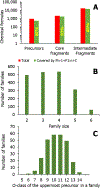Unsupervised Structural Classification of Dissolved Organic Matter Based on Fragmentation Pathways
- PMID: 34981937
- PMCID: PMC11293370
- DOI: 10.1021/acs.est.1c04726
Unsupervised Structural Classification of Dissolved Organic Matter Based on Fragmentation Pathways
Abstract
Dissolved organic matter (DOM) is considered an essential component of the Earth's ecological and biogeochemical processes. Structural information of DOM components at the molecular level remains one of the most extraordinary analytical challenges. Advances in determination of chemical formulas from the molecular studies of DOM have provided limited indications on structural signatures and potential reaction pathways. In this work, we extend the structural characterization of a wetland DOM sample using precursor and fragment molecular ions obtained by a sequential electrospray ionization-Fourier transform-ion cyclotron resonance tandem mass spectrometry (ESI-FT-ICR CASI-CID MS/MS) approach. The DOM chemical complexity resulted in near 900 precursors (P) and 24 000 fragment (F) molecular ions over a small m/z 261-477 range. The DOM structural content was dissected into families of structurally connected precursors based on neutral mass loss patterns (Pn-1 + F1:n + C) across the two-dimensional (2D) MS/MS space. This workflow identified over 1900 structural families of DOM compounds based on a precursor and neutral loss (H2O, CH4O, and CO2). The inspection of structural families showed a high degree of isomeric content (numerous identical fragmentation pathways), not discriminable with sole precursor ion analysis. The connectivity map of structural families allows for the visualization of potential biogeochemical processes that DOM undergoes throughout its lifetime. This study illustrates that integrating effective computational tools on a comprehensive high-resolution mass fragmentation strategy further enables the DOM structural characterization.
Keywords: DOM; ESI-FT-ICR MS/MS; core fragment; network; neutral loss; precursor.
Conflict of interest statement
The authors declare no competing financial interest.
Figures






Similar articles
-
Description of Dissolved Organic Matter Transformational Networks at the Molecular Level.Environ Sci Technol. 2023 Feb 14;57(6):2672-2681. doi: 10.1021/acs.est.2c04715. Epub 2023 Feb 1. Environ Sci Technol. 2023. PMID: 36724500 Free PMC article.
-
Complementary Elucidation of the Molecular Characteristics of Groundwater Dissolved Organic Matter Using Ultrahigh-Resolution Mass Spectrometry Coupled with Negative- and Positive-Ion Electrospray Ionization.Environ Sci Technol. 2023 Mar 21;57(11):4690-4700. doi: 10.1021/acs.est.2c08816. Epub 2023 Mar 11. Environ Sci Technol. 2023. PMID: 36905367
-
Graph Theoretic Approach for the Analysis of Comprehensive Mass-Spectrometry (MS/MS) Data of Dissolved Organic Matter.Proceedings (IEEE Int Conf Bioinformatics Biomed). 2021 Dec;2021:3742-3746. doi: 10.1109/bibm52615.2021.9669289. Proceedings (IEEE Int Conf Bioinformatics Biomed). 2021. PMID: 35425661 Free PMC article.
-
Screening of synthetic PDE-5 inhibitors and their analogues as adulterants: analytical techniques and challenges.J Pharm Biomed Anal. 2014 Jan;87:176-90. doi: 10.1016/j.jpba.2013.04.037. Epub 2013 May 6. J Pharm Biomed Anal. 2014. PMID: 23721687 Review.
-
Two-dimensional mass spectrometry: new perspectives for tandem mass spectrometry.Eur Biophys J. 2019 Apr;48(3):213-229. doi: 10.1007/s00249-019-01348-5. Epub 2019 Mar 13. Eur Biophys J. 2019. PMID: 30863873 Free PMC article. Review.
Cited by
-
Hepatoprotective Activity of Lignin-Derived Polyphenols Dereplicated Using High-Resolution Mass Spectrometry, In Vivo Experiments, and Deep Learning.Int J Mol Sci. 2022 Dec 16;23(24):16025. doi: 10.3390/ijms232416025. Int J Mol Sci. 2022. PMID: 36555683 Free PMC article.
-
Mass Difference Matching Unfolds Hidden Molecular Structures of Dissolved Organic Matter.Environ Sci Technol. 2022 Aug 2;56(15):11027-11040. doi: 10.1021/acs.est.2c01332. Epub 2022 Jul 14. Environ Sci Technol. 2022. PMID: 35834352 Free PMC article.
-
Pathways and selectivity of Fenton degradation of different precursor species of dissolved organic matter.Nat Commun. 2025 Jul 10;16(1):6361. doi: 10.1038/s41467-025-61753-7. Nat Commun. 2025. PMID: 40640206 Free PMC article.
-
Temporal Dynamics and Intermediate Product Formation in DOM Phototransformation Revealed by Liquid Chromatography Ultrahigh-Resolution Mass Spectrometry.Environ Sci Technol. 2025 Jul 15;59(27):13787-13797. doi: 10.1021/acs.est.5c01986. Epub 2025 Jun 28. Environ Sci Technol. 2025. PMID: 40580122 Free PMC article.
-
Enhancing Molecular Characterization of Dissolved Organic Matter by Integrative Direct Infusion and Liquid Chromatography Nontargeted Workflows.Environ Sci Technol. 2024 Jul 16;58(28):12454-12466. doi: 10.1021/acs.est.4c00876. Epub 2024 Jul 3. Environ Sci Technol. 2024. PMID: 38958378 Free PMC article.
References
-
- Dittmar T; Stubbins A 12.6 - Dissolved Organic Matter in Aquatic Systems. In Treatise on Geochemistry, 2nd ed.; Holland HD; Turekian KK, Eds.; Elsevier: Oxford, 2014; pp 125–156.
-
- Hertkorn N; Harir M; Cawley KM; Schmitt-Kopplin P; Jaffé R Molecular characterization of dissolved organic matter from subtropical wetlands: a comparative study through the analysis of optical properties, NMR and FTICR/MS. Biogeosciences 2016, 13, 2257–2277.
-
- Lu K; Liu Z Molecular Level Analysis Reveals Changes in Chemical Composition of Dissolved Organic Matter From South Texas Rivers After High Flow Events. Front. Mar. Sci. 2019, 6, No. 673.
-
- Kurek MR; Poulin BA; McKenna AM; Spencer RGM Deciphering Dissolved Organic Matter: Ionization, Dopant, and Fragmentation Insights via Fourier Transform-Ion Cyclotron Resonance Mass Spectrometry. Environ. Sci. Technol. 2020, 54, 16249–16259. - PubMed
-
- Xu W; Gao Q; He C; Shi Q; Hou Z-Q; Zhao H-Z Using ESI FT-ICR MS to Characterize Dissolved Organic Matter in Salt Lakes with Different Salinity. Environ. Sci. Technol. 2020, 54, 12929–12937. - PubMed
Publication types
MeSH terms
Substances
Grants and funding
LinkOut - more resources
Full Text Sources
Miscellaneous

